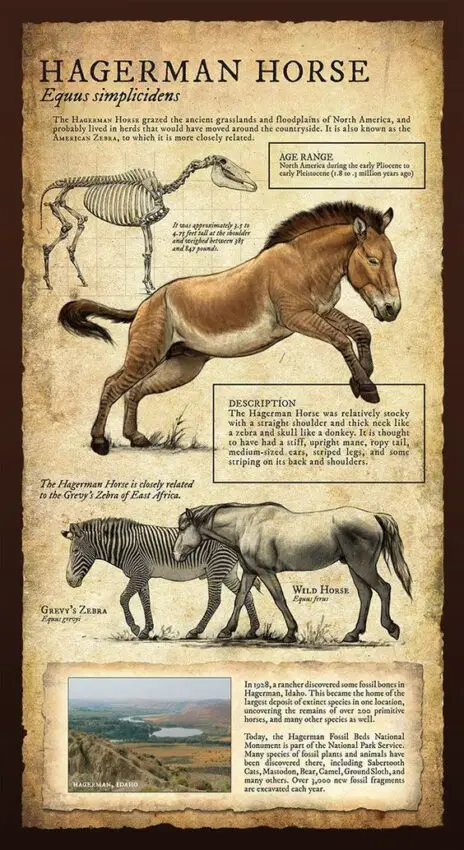Hagerman Idaho, USA, is the home to the largest deposit of Pliocene early horses of 3.5 million years ago along with many other fossils.
What are Hagerman Horses?
Table of Contents
Found in 1928 by Elmer Cook, a local rancher in Idaho, USA, pre-historic fossil bones of horses were found to be remarkably similar to the living Grevy’s Zebra of East Africa, and about the height of the modern Arabian horse. Pioneers traveling along the Oregon Trail noticed strange bones along the bluffs above the Snake River, but no more was said or done until the 1928 discovery.
The Hagerman Fossil Beds
Located in Southern Idaho near the Snake River and the city of Twin Falls, Hagerman was once a lush warm, and wet floodplain and grasslands fed by over 20 inches of rain per year (today it receives less than 10 inches of rain per year).
The Hagerman Fossil beds are extremely important as they not only contain the largest collection of Hagerman Horses in North America, but the beds also contain the richest fossil deposits in the world from 3.5 million years ago, during the late Pliocene era prior to the last Ice Age. Over 220 fossil plants and animals have been recovered from these fossil beds.
What is the Hagerman Horse
The excavation at the Hagerman Horse Quarry in Idaho has produced 30 complete skeletons of the Hagerman Horse, more than 100 skulls, as well as numerous isolated bones. Over 200 samples of horses of all ages and both sexes were discovered, the largest find of this species from any one location.
The Hagerman Horse was very similar to the Zebra of East Africa today. It had one toe or hoof, a thick body, and neck, a head similar to a donkey, and may have had a short stiff mane like the modern zebra. From the Pliocene Epoch, the Hagerman Horse originated in North America and has been recognized as the state fossil of Idaho today.

The Hagerman Horse is known scientifically as Equus simplicidens, the oldest horse of the genus Equus, which goes back as far as 3.5 million years, and became extinct about 10,000 years ago. Equus, is the genus that includes all modern horses, donkeys, and zebras. The Hagerman specimens are from the Pliocene and Pleistocene ages.
The Hagerman Horses, recovered from fluvial sandstone beds, were thought to have been a herd at a watering hole suddenly swept away by a catastrophic flood, deposited and buried by subsequent flooding events. Other Hagerman Equus simplicidens specimens have been found in Nebraska, Florida, and Texas, but they are all much younger, making the sample from Idaho the oldest on record.
Other Finds at the Hagerman Quarry
Like the Pleistocene beds of the La Brea Tar Pits of Los Angeles, California, the Idaho quarry also yielded many other similar specimens from the Pliocene Epoch.
Just some of the animals discovered in Idaho’s Hagerman Fossil Beds include beavers, antelopes, muskrats, snakes, turtles, otters, birds, fish, deer, camels, mastodons, horses, peccaries, swans, ground squirrels, pocket gophers, shrews, ducks, cormorants, saber-toothed cats, hares, ground sloths, dirk tooth cat, and a bone-crushing dog like the hyena.
It is known that the horse and the camel originated in North America and spread to other continents before becoming extinct in their homeland. Other animals such as sloths and mastodons originated on other continents before spreading to North America. Most of these animals that are now extinct disappeared from North America over the last Ice Age.
It is speculated by some that the horse may have been annihilated by over-hunting by early human inhabitants of North America, or by drought or disease. The horse did not reappear after the last Ice Age until brought to America by the Spanish in the 16th century.
Resources:
Hagerman Fossil Beds National Monument. National Park Service. Nps.gov
Idaho: Equus simplicidens (state fossil) StateFossils.com.
